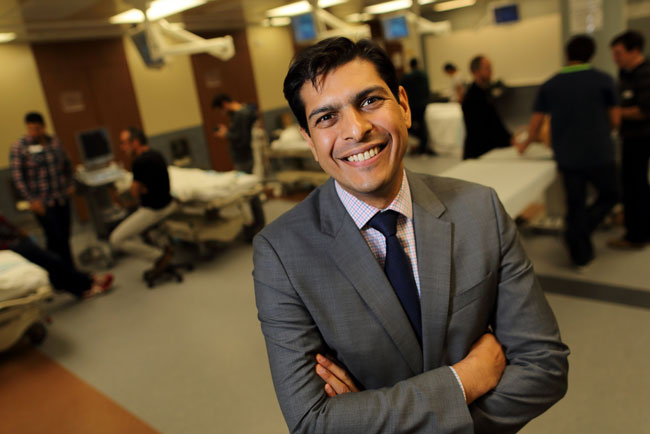
In light of last week’s $7.5-million gift to the Steinberg Centre for Simulation & Interactive Learning by Arnold and Blema Steinberg, Dr. Rajesh Aggarwal, Director of the Steinberg Centre, writes about the importance of simulation training for the wellbeing of patients and our healthcare system.
By Dr. Rajesh Aggarwal
For as long as I can remember, I wanted to be a doctor, but more specifically, a surgeon. One of my earliest memories is seeing my father dressed in green scrubs, wearing white plastic boots, on his way to the operating room. How amazing, I thought, to be able to do this when I grow up.
Whilst I knew the training would be long with arduous nights and weekends on call, it was not until I became a medical student that I realized how much of what I learned would be through practice on patients. The first time I took a medical history, it was nerve racking. What if I asked the wrong questions? Even tougher was drawing blood. Luckily, as medical students, we practised on each other first. Learning through practice is necessary. Practising on live patients is not.
In medicine, we in fact have used simulation-based training for close to 50 years. The use of animal tissue, mannequins and, more recently, computer-based simulation, is rife in every medical school in Canada. Medical simulation to train residents to place an intravenous line into the jugular vein in the neck has been shown to reduce infection rates by an astounding 84 per cent. A simulation-based team-training program for operating room staff in the United States led to a 50 per cent greater decrease in mortality rates across 74 hospital sites than sites that had not undergone the training. These are only a few of countless examples.
Yet, Dr. John James from Patient Safety America, suggests in a 2013 publication in the Journal of Patient Safety that overall medical error is actually on the rise, by up to four-fold from the figures quoted at the start of this century. While medicine has become increasingly complex, our training programs have in many ways remained the same.
Whilst the facilities and equipment exist, training in simulation centres is still a minute part of the curriculum. In order to truly make health care safer, we need to simulate over and over again. We need to be rigorously assessed to a level of competence, and then and only then, deliver care to our patients. Medicine is now a team sport; we need to train as teams, too, in simulated settings. We also need to think about the whole care pathway, not just what happens in the hospital. Using simulation to teach clinicians to manage patients with chronic diseases, such as diabetes or arthritis, in their own homes or community clinics, can prevent unnecessary admission to hospital and reduce health care costs.
Simulation must also be used to empower patients by educating them about managing their own care – to be an active participant in the health care team – something that has never been done before. Furthermore, simulation should be integrated into the health care innovation pathway; new devices, procedures and processes of care, can be developed, tested and trained for, in a simulated setting, to measure their effectiveness and efficiency, prior to being deployed in the clinical arena.
Simulation must be embedded into the training, re-training and evaluation of every clinician, to ensure that no patient is exposed to a preventable error again. We are indebted to our patients, and it is incumbent on us to ensure we train in a manner that results in the best possible care, every single time, to every single one of our patients. It is only with this imperative, that we can hope to reverse the rising trend of medical error that is now pandemic across industrialized nations.
Dr. Rajesh Aggarwal is an Associate Professor of Surgery at McGill University, and Director of the Steinberg Centre for Simulation & Interactive Learning
Related story
New vision, new name for health care simulation at McGill
